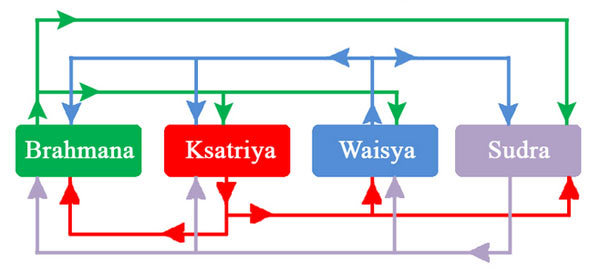Genetic Study Reveals Origin of India's Caste System
A new genetic study published in the American Journal of Human Genetics has revealed that the Indian caste system– which is the traditional organisation of South Asian society into a hierarchy of hereditary groups – may have originated up to 2,000 years ago.
In broad outline, the caste system dictates that marriage only occurs within caste, that it is fixed by birth, and that each caste is associated with a traditional occupation, such as weaving or barbering. Hindu religious principles underlay the caste hierarchy and limit the ways that castes can interact.
Researchers analysed the DNA from 371 people who were members of 73 groups throughout the subcontinent and found that people from different genetic populations in India began mixing about 4,200 years ago, but the mingling stopped around 1,900 years ago. They combined these results with clues from ancient texts, which suggest that class distinctions emerged 3,000 to 3,500 years ago, and caste divisions became strict roughly two millennia ago.
The Rigveda, a nearly 3,500-year-old collection of hymns written in Sanskrit, refer to three main classes of people – the priests, the nobility and the common people – but there was no reference to segregation or occupational restrictions. However, by about 1,000 BC, the texts mention a fourth, lowest class: the Sundras. But it wasn’t until about 100 BC that a holy text called the Manusmruti explicitly stated that marriage across castes was forbidden, and this is also reflected in the genetic analysis which revealed that mixing between castes stopped around this time.
Though relationships between people of different social groups was once common, there was a "transformation where most groups now practice endogamy," or marry within their group, said study co-author Priya Moorjani, a geneticist at Harvard University.
The caste system is connected to the Hindu concept of the four varnas, which order and rank humanity by innate spiritual purity. The highest varna is the Brahmins, or priests. Next comes the Kshatriyas, the warriors, and then the Vaishyas, the merchants. The lowest varna is the Shudras, consisting of labourers, artisans and servants who do work that is ritually unclean. In the past these castes were called untouchables, who were discriminated against and prohibited from participating in religious rituals, drinking from wells used by higher castes, or even letting their shadows fall on a Brahmin.
As India approached independence from British rule in the early 20 th century, the caste system was increasingly criticised as discriminatory and unjust. The current Indian constitution now bans discrimination on the basis of caste and the use of the term ‘untouchable’. The growth of information-age India has reduced the economic importance of the caste system, but its social and religious aspects remain a significant and sometimes divisive part of Indian life.



















